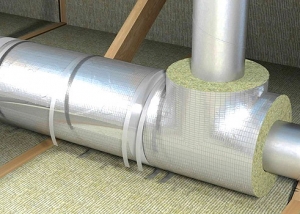Ducts are structural elements that relate to the main part of ventilation systems. They can have a different cross-sectional shape and are made from different materials. In order to carry out the optimal calculation of the air system, it is necessary to take into account the dimensions of its individual elements, and also to calculate two more important parameters, namely: air flow rate and its speed.
Content
Duct material and cross-sectional shape
First of all, for the organization of air transport communication, it is necessary to determine the material from which it will be made. In addition, you must correctly select the cross-sectional shape of the ventilation pipes. The shape of the cross section is an important parameter that affects the throughput indicators of communication.
As for the manufacturing materials, each of them has its own characteristics, one of which is the coefficient of friction. Here there is one dependence: the higher the coefficient of friction of the material, the greater the resistance to the air flow.
The ventilation system can be made of different materials. Consider the main ones:
- stainless steel;
- galvanized steel;
- plastic.
The selection of material is made taking into account the qualitative characteristics of the air mixture, as well as focusing on financial capabilities in a particular case.
In turn, the shape of the cross section of the ducts can be:
- round;
- rectangular.
Today, round ducts are more popular. This is due to the fact that their cost is lower than for rectangular analogues. In addition, such ducts have a high throughput, which contributes to the high-quality circulation of air flows.
Helpful information! For the organization of normal ventilation, the speed of movement of gases through ventilation communication should be at least 0.2 m / s and not exceed 1 m / s.

The speed of air mass movement is related to the diameter of the pipe, therefore, when designing a ventilation system, this parameter is taken into account first
Consider the geometric parameters that should be considered when designing ventilation:
- sectional area of the ventilation pipe;
- volume of consumed air;
- air speed.
The correct selection of the duct
Of the three main parameters that were described above, only one is regulated, namely: the cross-sectional area of a round or rectangular duct. The building codes and rules clearly indicate the range of cross-sectional indicators and other geometric dimensions that must be observed for the installation of normal airway communications.
The remaining two indicators are not regulated, since the amount of air used can be different, as well as the speed of its movement. Thus, these indicators are not normalized and are determined individually. The exception to this is pre-school and school facilities, as well as buildings that are related to the health sector.
The speed of air flow is determined depending on the purpose of the ventilation system.There is mechanical and natural ventilation of buildings. In the first case, the circulation of air flows is due to special devices (fans or ejectors). In turn, during natural ventilation, the movement of the working medium along the channel occurs due to the difference in pressure indicators outside and inside the building. The dependence of the air velocity on the purpose of the ventilation system is presented in the table.
Table 1
| Duct designation | Trunk | Side branch |
| Recommended Speed | 6 to 8 m / s | 4 to 5 m / s |
Natural air circulation through the ventilation system implies a speed of 0.2 to 1 m / s. However, in some cases, the speed in natural ventilation can reach 2 m / s.

Calculation of air velocity in the designed duct is carried out according to special formulas, and in an existing one, it is measured by a special device
Aerodynamic design of air ducts: calculation procedure
In order to calculate the air velocity in the duct, you must use one of the following methods:
- use the calculator to calculate the speed in the duct. Such calculators can be easily found on the Internet;
- calculate the air velocity in the duct using special formulas.
Consider a formula that is suitable for determining the speed of movement of air masses by communication:
ϑ = L x F, where:
L is an indicator that determines the air flow in a particular section of air transport communication. This indicator is calculated in m³ / h; F is a parameter that determines the cross-sectional area of the duct and is calculated in m².
This formula allows a fairly accurate calculation of the actual speed in the duct. The cross-sectional index of a round ventilation pipe is found using the following formula:
F = π x D2 / 4, where:
π is the mathematical constant, which is 3.14; D is the cross-sectional indicator, calculated in m.
Note! The index of the cross-sectional area of a rectangular ventilation pipe is determined as follows: it is necessary to measure the width of the pipe and its height, and then multiply these two indicators.
Useful Tips
The air velocity increases in direct proportion to the reduction in pipe size. Consider some of the positive points that can be drawn from this rule:
- if the dimensions of the room in which the ventilation duct will be laid are not suitable for organizing large communications or additional branches, then pipes of smaller sizes are ideal;
- ventilation, which differs in small dimensions, is more compact and its installation is less labor intensive;
- the lower the duct cross-section, the lower its price. This is due to the fact that much less material is spent on pipes of small sizes.
However, experts recommend appropriate calculations of the pressure that will be exerted on the walls of a small channel. The pressure indicators in this case are much higher, which is explained by the increased air velocity.






